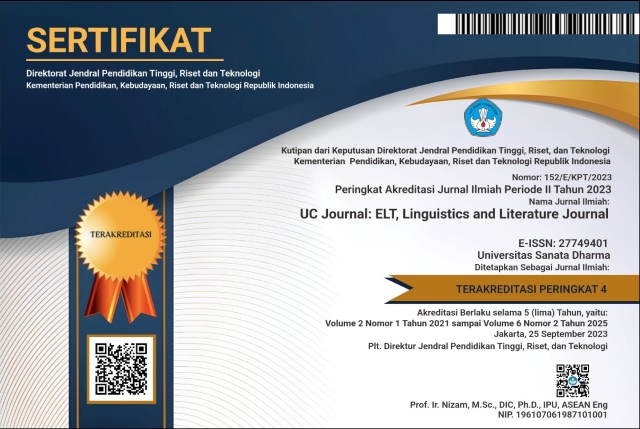THE BENEFITS OF SKIMMING TECHNIQUE IN READING COMPREHENSION FOR THE SECOND SEMESTER STUDENTS OF SANATA DHARMA UNIVERSITY
(1) Independent Contributor, Nias, North Sumatera
(*) Corresponding Author
Abstract
Reading is a process to make sense written ideas through a meaningful interpretation and interaction with the language (Heilman & Blair, 1981). One of the techniques that can be used in reading process is the skimming technique. Skimming is used when a reader wants to cover the main idea of the text in a hurry. Basic Reading II class was chosen as the object of the research because reading techniques are covered in this semester. This research is aimed to answer a research question, namely: How does the skimming technique influence students reading comprehension? To answer the research question, the researcher used a quantitative method. Questionnaire was considered as the instrument. The researcher distributed the questionnaire to 28 students in Basic Reading II class C of ELESP of Sanata Dharma University to collect data. The results showed that most of students positively responded that the skimming technique gave them benefits in their reading activity, such as increases their interest in learning English, saves their time, eases students to predict the content, helps students to find the main idea, and keeps them informed about the text.
Keywords
Full Text:
PDFReferences
Ary, D., Jacobs, L. C., & Razavieh, A. (1979). Introduction to research in education (2nd ed.). New York: Holt Rine and Winston Inc.
Brown, H. D. (2004). Language assessment principles and classroom practice. New York: Pearson Education Ltd.
Carrel, P. L. & Eisterhold, J. (1987). Schema theory and ESL reading pedagogy methodology in TESOL: A book of readings. Midtown East, NY: Newbury House Publishers.
Cohen, L., Manion, L., & Morrison K. (2000). Research method in education. (5th ed.). New York: Routledge Falmer.
Dreyer, C. (1998). Improving students reading comprehension by means of strategy instruction. Journal for Language Teaching, 32, 18-29.
Eskey, D. E. (1986). Theoretical foundations: Teaching second language reading for academic purposes. Redwood, CA: Addition-Wesley Publishing Company.
Fry, E. (1963). Teaching faster reading. London: Cambridge University Press.
Grayum, H. S. (1953). What is skimming? What are its uses at different grade levels? International Reading Association, 7(2), 111-114.
Heilman, B. (1987). Principles and practice of teaching reading. (5th ed.). Ohio: Bell & Howell Company.
Hanckock, O. (1987). Reading skills for college students. Upper Saddle River, NJ: Prentice Hall, Inc.
Jonhson, B. & Christensen, L. (2012). Educational research quantitative, qualitative, and mixed approach (4th ed.). Thausand Oaks, CA: Sage Publication, Inc.
Kucer, S. (1987). The cognitive base of reading and writing. Urbana, IL: National Conference on Research in English.
Langan, J. (1986). Reading and study skills: Form A. New York, US: McGraw-Hill College.
Leedy, P. D. (1993). Practical research: Planning and design. Upper Saddle River, NJ: Prentice-Hall.
Mikulecky, B. S. (1990). A short course in teaching reading skills. Redwood, CA: Addison-Wesley Publishing Company, Inc.
Mikulecky, B. S. & Jeffries, L. (2004). More reading power. New York: Pearson Eduction Ltd.
Moyle, D. (1972). The teaching of reading (3rd ed.). London: The Garden City Press.
Nuttal, C. (1982). Teaching reading skill in a foreign language. London: Heinemann Educational Books.
Patmawati, S. (2015). The implementation of skimming and scanning techniques in a reading class in junior high school. Edupedia: Jurnal Ilmu Sosial dan Humaniora, 1(2), 116-118.
Simanjuntak, E. (1988). Developing reading skills for EFL students. Jakarta: (n.p.)
Wallace, C. (1992). Reading. In C. N. Candlin & H. G. Widdowson (Eds.). New York: Oxford University Press.
Weiss, I. (1967). Skimming practice. National Council of Teachers of English, 56(1), 135-137.
Whipple, G. M. & Curtis, J. N. (1917). Preliminary investigation of skimming in reading. Journal of Educational Psychology, 8(6), 333-349.
Wilson, N. & McLean, S. (1994). Questionnaire design: A practical introduction. Newtownabbey, Belfast: University of Ulster Press.
DOI: https://doi.org/10.24071/uc.v1i1.2848
Refbacks
- There are currently no refbacks.
Copyright (c) 2020 Sintya Nirwana Gulo

This work is licensed under a Creative Commons Attribution-ShareAlike 4.0 International License.
UC Journal is indexed in:
UC Journal Sinta 4 Certificate (S4 = Level 4)
We would like to inform you that UC Journal: ELT, Linguistics and Literature Journal, or UC Journal has been nationally accredited Sinta 4 by the Ministry of Education, Culture, Research and Technology of the Republic of Indonesia based on the decree No. Surat Keputusan 152/E/KPT/2023. Validity for 5 years: Vol 2 No 1, 2021 till Vol 6 No 2, 2025
DOI: https://doi.org/10.24071/uc
e-ISSN (validity starting Vol 1, No 2, November 2020): 2774-9401

This work is licensed under CC BY-SA.
Creative Commons Attribution-ShareAlike 4.0 International License
 UC Journal: ELT, Linguistics and Literature Journal, a scientific peer-reviewed journal, was established in 20 May 2020 and is published twice a year, namely in May and November, by the English Language Education Study Programme (S1/Sarjana PBI) in collaboration with the English Education Master's Programme (S2/Magister PBI) of Sanata Dharma University, Yogyakarta, Indonesia.
UC Journal: ELT, Linguistics and Literature Journal, a scientific peer-reviewed journal, was established in 20 May 2020 and is published twice a year, namely in May and November, by the English Language Education Study Programme (S1/Sarjana PBI) in collaboration with the English Education Master's Programme (S2/Magister PBI) of Sanata Dharma University, Yogyakarta, Indonesia.














